We’re reader-supported. When you buy through links on our site, we may earn an affiliate commission. Disclosure
Trekking poles are essential gear for any backpacker, providing stability and support on difficult terrain while reducing the impact on your knees and joints. With so many options on the market, it can be overwhelming to choose the right pair. After extensive research and personal experience backpacking in the northeastern United States, I’ve compiled a list of the best trekking poles for backpacking.
Finding the Best Trekking Poles for Backpacking
The ideal trekking poles for backpacking may differ based on the requirements and interests of each hiker. Some may prioritize comfort and durability over weight, while others may need poles with extra features such as shock absorption or adjustable grips for increased stability. Many hikers prefer lightweight poles to help keep their trail weight down as well.
Regardless of your specific needs, investing in a quality pair of trekking poles can greatly improve your hiking experience. They provide stability on uneven terrain, reduce strain on your joints, and can even help you move faster and more efficiently. Only quality manufacturers design the products reviewed in this guide, with a long history of making great outdoor gear.
Leki Makalu FX Carbon Trekking Poles ($229.95)
Unquestionably among the best trekking poles for backpacking are the Leki Makalu FX Carbon Trekking Poles. These poles are made of high-modulus carbon shafts, which makes them super light and stiff. This means they are easy to carry and maneuver while providing optimal swing weight.

One of the standout features of these trekking poles is the Speed Lock 2+ lever system. This system allows for fast and easy length adjustment between 110 and 130 cm, even when you’re wearing gloves. Additionally, this system is smaller and lighter than the Speed Lock 1, while still delivering a 20% higher holding force. This means that you can easily adjust the length of the poles to match the terrain you’re hiking on, without having to worry about them slipping or collapsing.
The handle material on these poles is also top-notch. The Aergon Thermo Long Grip is made of a soft and comfortable material that is easy to grip, even when your hands are sweaty or wet. The grip is also designed to fit the shape of your hand, which means that you can comfortably hold onto these poles for hours on end.

Finally, these trekking poles are incredibly durable. The high-modulus carbon shafts are built to withstand the rigors of backpacking, and the Speed Lock 2+ lever system is designed to last for years of use. Overall, if you’re looking for a set of trekking poles that are lightweight, easy to use, and built to last, then the Leki Makalu FX Carbon Trekking Poles are definitely worth considering.
Black Diamond Alpine Carbon Cork Trekking Poles ($199.95)
The Black Diamond Alpine Carbon Cork Trekking Poles are some of the best trekking poles for backpacking on the market today. The 3-section carbon-fiber shaft is incredibly lightweight, making it easy to carry on long hikes, but also strong and durable enough to withstand heavy use. The dual FlickLock Pro adjustability system allows for quick and secure length changes, making it easy to adjust the poles to fit your needs on the trail.
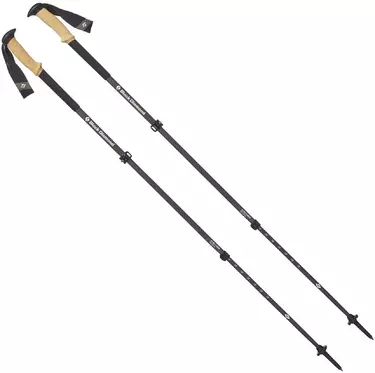
The excellent cork grips on these hiking poles are one of their best qualities. Not only do they provide a comfortable and secure grip, but they also have soft rubber grip extensions and solution straps for even better handling and security. This is especially important when hiking in rough terrain or on steep inclines.
These poles also come equipped with interchangeable carbide Tech Tips and 38mm trekking baskets, making them versatile enough to handle a variety of different terrains and conditions. And despite all of these features, they still manage to be incredibly lightweight, coming in at just 17 ounces per pair.

In short, the Black Diamond Alpine Carbon Cork Trekking Poles are a great option for backpackers looking for a compact, robust, and adaptable pair of trekking poles. With high-quality materials, comfortable grips, and a range of useful features, these poles are sure to be a reliable companion on any hiking adventure.
REI Co-op Traverse Trekking Poles ($119)

The REI Co-op Traverse Trekking Poles are a top-performing choice for backpackers due to their high-quality construction and useful features. These poles are made with durable aluminum, which makes them strong enough to withstand the rigors of extended backpacking trips. The aluminum construction also keeps the weight of each pole at a reasonable 9.6 ounces, which is light enough to carry for extended periods without causing fatigue.
The handle material is made of cork, which provides a comfortable grip and helps to absorb sweat during hot weather. The cork handle also conforms to the shape of your hand over time, making it more comfortable to hold and use. The poles also feature a foam grip extension that allows for easy adjustments when traversing steep terrain.
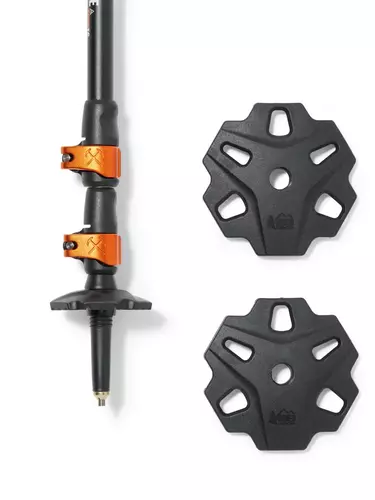
One of the standout features of the REI Co-op Traverse Trekking Poles is their adjustability. The poles can be adjusted to fit users ranging from 4’10” to 6’4″, making them a versatile choice for backpackers of all sizes. The adjustable locking mechanism is also easy to use, allowing you to quickly adjust the length of the poles to suit your needs.
Overall, the REI Co-op Traverse Trekking Poles are an excellent choice for backpackers who need a durable and versatile set of trekking poles. Their aluminum construction, cork handle material, and adjustable design make them one of the best options available for backpacking trips.
Black Diamond Distance Z Trekking Poles ($139.95)
The Black Diamond Distance Z Trekking Poles are a fantastic choice for backpackers looking for a reliable, lightweight, and durable set of trekking poles. These poles are designed with the everyday adventurer in mind, and they deliver on all fronts.

One of the key features of these trekking poles is their build material. The 7075 aluminum shafts are both lightweight and tough, making them perfect for long hikes and backpacking trips. The Z-pole fixed-length construction with speed-cone deployment is also a standout feature, allowing for fast and easy collapsing when you need to pack them away quickly.
Another great feature of these trekking poles is their handle material. The EVA foam grip is comfortable to hold and provides excellent traction, even when your hands are sweaty or wet. The breathable, moisture-wicking strap is also a nice touch, helping to keep your hands dry and comfortable throughout your hike.
Regarding weight, the Black Diamond Distance Z Trekking Poles are hard to beat. Weighing in at just 9 ounces per pole, they are incredibly lightweight and won’t weigh you down on long hikes or backpacking trips. Despite their light weight, they are also incredibly durable, making them a great investment for any serious backpacker.
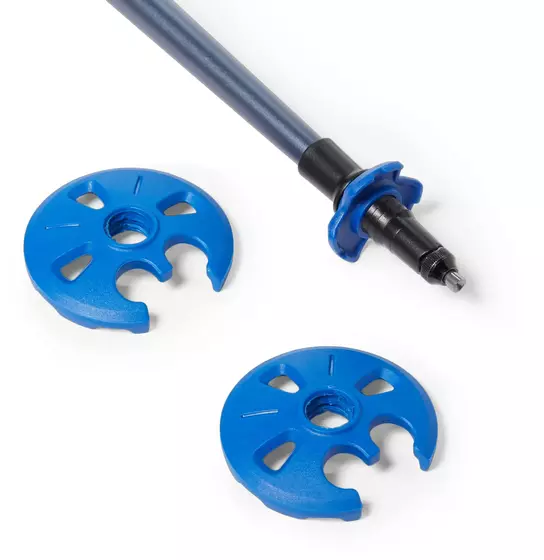
The Black Diamond Distance Z Trekking Poles are among the top trekking poles for backpacking available today. With their lightweight, durable build, comfortable handle material, and easy collapsing design, they are the perfect companion for any adventurous backpacker.
Leki Khumbu Lite Trekking Poles ($119.95)

The Leki Khumbu Lite Trekking Poles are one of the best trekking poles for backpacking and a great budget trekking pole choice. These 3-section, collapsible poles are constructed with heat-treated HTS 6.5 aluminum, making them sturdy, durable, and light. The Aergon Cor-Tec ergonomic grips feature a lightweight, edgeless design for optimum comfort and various gripping positions. The built-in 8° positive angle of the grips keeps wrists in a neutral position, providing more comfort and less fatigue on long treks.
One of the standout features of these poles is their weight. At just 1 lb. 1.6 oz. for the pair, they are incredibly lightweight, making them perfect for backpackers who want to keep their pack weight down. Despite their lightweight, they are still incredibly durable and can stand up to the rigors of backpacking.
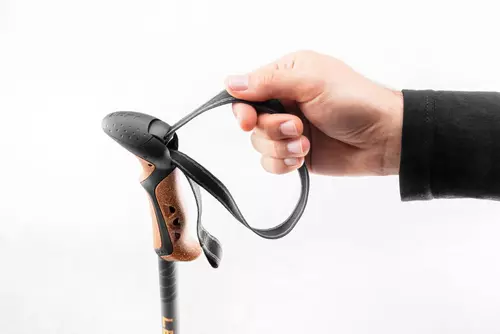
Overall, the Leki Khumbu Lite Trekking Poles are an excellent choice for backpackers who want a high-quality, durable, and lightweight trekking pole at a budget-friendly price. With their sturdy build, comfortable grips, and lightweight design, these poles are sure to enhance any backpacking trip.
REI Co-op Trailmade Trekking Poles ($79.95)
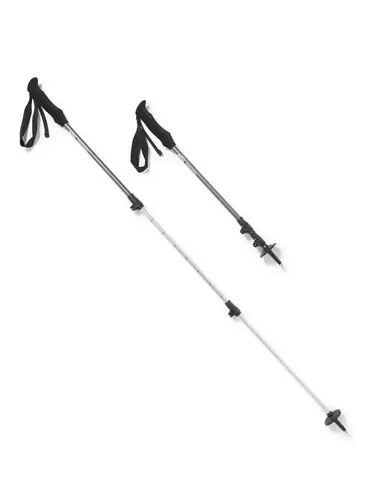
The REI Co-op Trailmade Trekking Poles are one of the best trekking poles for backpacking, especially for those on a budget. These poles are made of durable aluminum that can withstand rough terrain and heavy use. The adjustable height feature accommodates a wide range of users and the oversize levers make it easy to adjust the poles to adapt to slope angles.
The EVA foam grips are another standout feature of these trekking poles. They offer a light and breathable foam that is ergonomically designed to accommodate a variety of hand sizes and positions, ensuring maximum comfort during long treks. The grip material also provides a secure hold, even in wet conditions, making them a reliable choice for any hiking adventure.

At just over one pound per pair, these trekking poles are lightweight and easy to carry, making them ideal for backpacking trips. The included trail baskets are generously sized, providing excellent flotation on soft terrain, and the carbide tips provide reliable traction on rocky surfaces.
The REI Co-op Trailmade Trekking Poles are an excellent choice for backpackers looking for a durable and reliable trekking pole that won’t break the bank. With their sturdy build, comfortable grip, and lightweight design, these poles are sure to become a go-to choice for any hiking adventure.
Material and Durability
When it comes to trekking poles, material and durability are two of the most important factors to consider. In this section, I will discuss the differences between aluminum and carbon fiber poles and the importance of shock absorption.
Aluminum vs Carbon Fiber
The two most common materials used for trekking poles are aluminum and carbon fiber. Aluminum poles are generally more affordable and durable than carbon fiber poles. They are also heavier, which can be a disadvantage on long hikes. Carbon fiber poles are lighter and more expensive than aluminum poles. They are also more fragile and can break under heavy stress.
When choosing between aluminum and carbon fiber poles, it is important to consider your budget and the type of hiking you will be doing. If you are on a tight budget and plan to do mostly day hikes, aluminum poles may be the better choice. If you plan to do longer hikes and have a larger budget, carbon fiber poles may be worth the investment.
Shock Absorption
Shock absorption is another important factor to consider when choosing trekking poles. Shock absorption helps to reduce the impact on your joints and muscles, which can make hiking more comfortable and reduce the risk of injury.
Most trekking poles come with some form of shock absorption. Some poles have internal springs or dampeners, while others have external shock absorbers. The type of shock absorption you choose will depend on your personal preference and the type of hiking you will be doing.
In general, internal shock absorbers are more effective at reducing impact than external shock absorbers. However, external shock absorbers are more durable and easier to repair if they become damaged.
When choosing trekking poles, it is important to consider the type of shock absorption that will work best for you. If you plan to do mostly day hikes on easy terrain, internal shock absorbers may not be necessary. If you plan to do longer hikes on rough terrain, external shock absorbers may be a better choice.
Grip and Comfort
When it comes to trekking poles, grip and comfort are two of the most important factors to consider. In this section, I will discuss the different types of grips and which ones are best suited for backpacking.
Cork vs Foam vs Rubber
The three most common types of grips for trekking poles are cork, foam, and rubber. Each has its own advantages and disadvantages, and the choice ultimately comes down to personal preference.
Cork
Cork is a popular choice for trekking pole grips because it is comfortable, durable, and provides good traction even when wet. Cork also conforms to the shape of your hand over time, making it an excellent choice for long hikes.
However, cork can be more expensive than other types of grips, and it may not be as comfortable for people with sweaty hands. Additionally, cork can be damaged by exposure to sunlight or extreme temperatures.
Foam
Foam grips are lightweight and provide excellent cushioning, making them a good choice for people with sensitive hands or those who prefer a softer grip. Foam also provides good insulation in cold weather, which can be a significant advantage for backpackers.
However, foam can be less durable than other types of grips, and it may not provide as much traction as cork or rubber. Additionally, foam can absorb moisture, which can make it slippery and uncomfortable to hold.
Rubber
Rubber grips are durable, affordable, and provide excellent traction, making them a popular choice for backpackers. Rubber also provides good insulation in cold weather and is resistant to damage from exposure to sunlight or extreme temperatures.
However, rubber can be less comfortable than cork or foam, and it may not conform to the shape of your hand as well. Additionally, rubber can be heavy, which may be a consideration for backpackers who are trying to minimize weight.
In conclusion, the choice of grip for your trekking poles ultimately comes down to personal preference. Cork is a good choice for people who want a comfortable, durable grip, while foam is a good choice for people who want a softer, cushioned grip. Rubber is a good choice for people who want a durable, affordable grip with excellent traction.
Adjustability and Locking Mechanisms
When it comes to trekking poles, adjustability and locking mechanisms are important factors to consider. The ability to adjust the length of your poles can make a significant difference in your comfort and stability while hiking. Additionally, locking mechanisms ensure that your poles stay at the desired length and do not collapse unexpectedly.
Most trekking poles have adjustable lengths, allowing you to customize the height to your specific needs. This is especially important when hiking on uneven terrain, as you can adjust the length of each pole to match the slope of the ground. When the terrain is uphill, you can shorten the poles, and when it’s downhill, you can lengthen them.
There are two main types of locking mechanisms for trekking poles: twist locks and lever locks. Twist locks involve twisting the pole sections to secure them in place, while lever locks use a lever to clamp the sections together. Both types of locks can be effective, but lever locks are generally considered easier to use and more reliable.
It’s also important to consider the quality of the locking mechanism. Poorly designed locking mechanisms can slip or fail, causing your poles to collapse unexpectedly. Look for poles with high-quality locks that are easy to use and hold the sections securely in place.
In conclusion, adjustability and locking mechanisms are crucial factors to consider when choosing trekking poles. Look for poles with adjustable lengths and high-quality locking mechanisms to ensure your comfort and safety while hiking.
Maintenance and Care of Trekking Poles
As someone who uses trekking poles regularly, I know how important it is to take care of them. Proper maintenance can extend the life of your poles and ensure they function properly when you need them most. Here are some tips for maintaining and caring for your trekking poles:
Cleaning
After each use, wipe down your poles with a damp cloth to remove any dirt or debris. If your poles are particularly dirty, you can use a mild soap solution to clean them. Be sure to dry your poles thoroughly before storing them.
Storage
When storing your poles, make sure they are completely dry and that the sections are collapsed. This will prevent any moisture from getting trapped inside the poles, which can cause rust or corrosion. Store your poles in a cool, dry place away from direct sunlight.
Tightening Screws
Periodically check the screws on your poles to make sure they are tight. Loose screws can cause your poles to collapse unexpectedly, which can be dangerous. Use a screwdriver or the included tool to tighten any loose screws.
Lubrication
If your poles start to squeak or feel stiff, they may need to be lubricated. Apply a small amount of silicone lubricant to the joints and sections of your poles. Avoid using oil-based lubricants, as they can attract dirt and debris.
Tip Replacement
Over time, the tips of your poles may become worn or damaged. Most trekking poles come with replaceable tips, so be sure to check your manufacturer’s instructions for how to replace them. You can also purchase replacement tips online or at your local outdoor retailer.
By following these maintenance and care tips, you can ensure that your trekking poles are always in top condition and ready for your next adventure.

